Analysis of Costs and Revenues: Financial Reporting and Costing
VerifiedAdded on 2020/12/26
|19
|3782
|497
Report
AI Summary
This report provides a comprehensive analysis of costs and revenues, covering various aspects of financial reporting and costing systems. The report begins by exploring the purpose of internal reporting and the relationships between different costing systems, including marginal and absorption costing. It delves into the responsibility centers within an organization, such as cost centers, profit centers, and investment centers. The report then examines different cost classifications and their uses in costing. Further, it covers recording cost information for labor, material, and expenses and analyzing this information according to organizational costing procedures. It examines the various stages of inventory, inventory valuation methods (LIFO, FIFO, and weighted average), and the behavior of different cost types. The report also discusses the recording of cost information using various costing systems (job, batch, unit, process, and service costing). It then moves on to overhead costs, including their allocation and apportionment, calculation of overhead absorption rates, and adjustments for under or over-recovered overhead costs. The report also includes variance analysis, budget comparisons, and providing information for budget holders. Finally, it explores the estimation of future incomes and costs for decision-making, the effect of changing activity levels on unit costs, and factors affecting short-term and long-term decision-making.
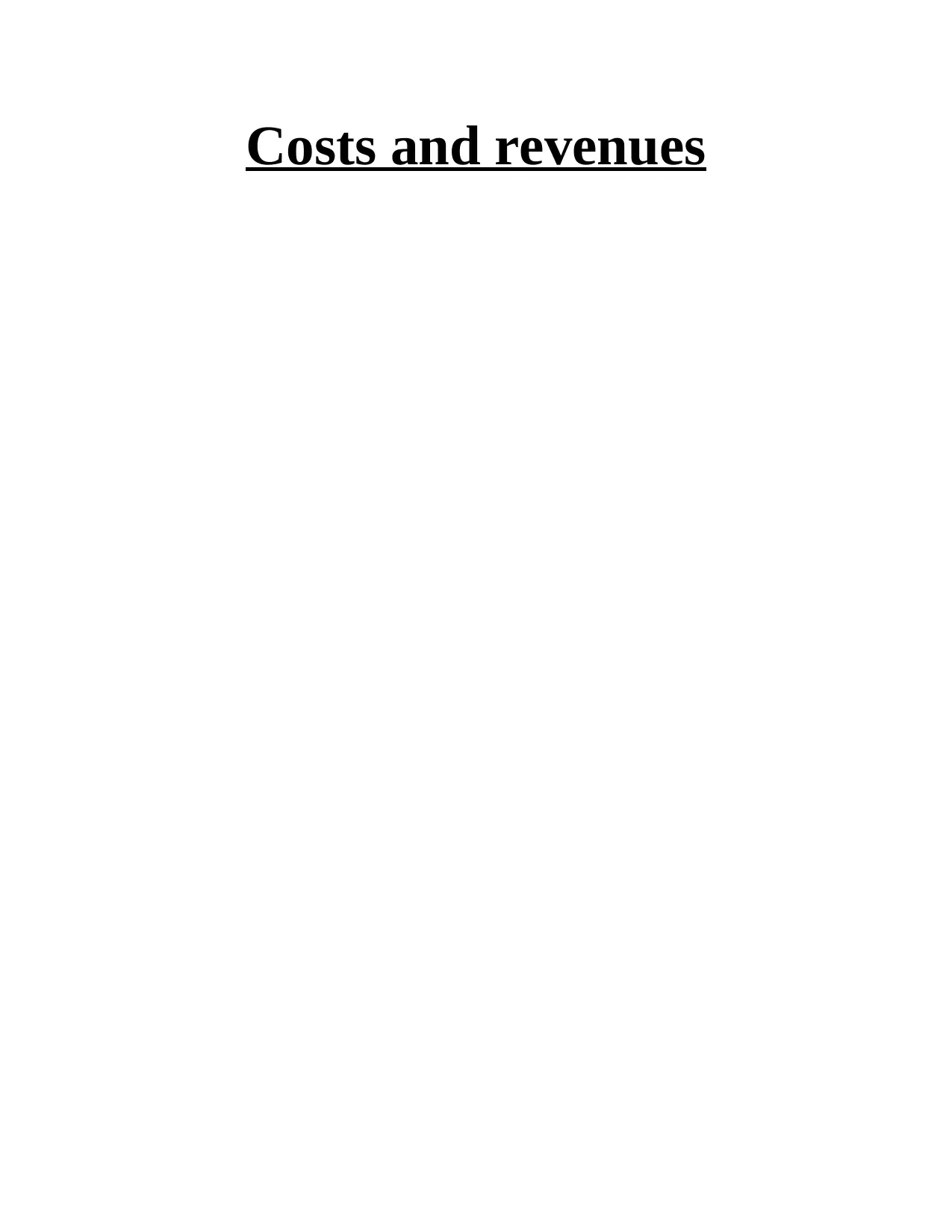
Costs and revenues
Paraphrase This Document
Need a fresh take? Get an instant paraphrase of this document with our AI Paraphraser
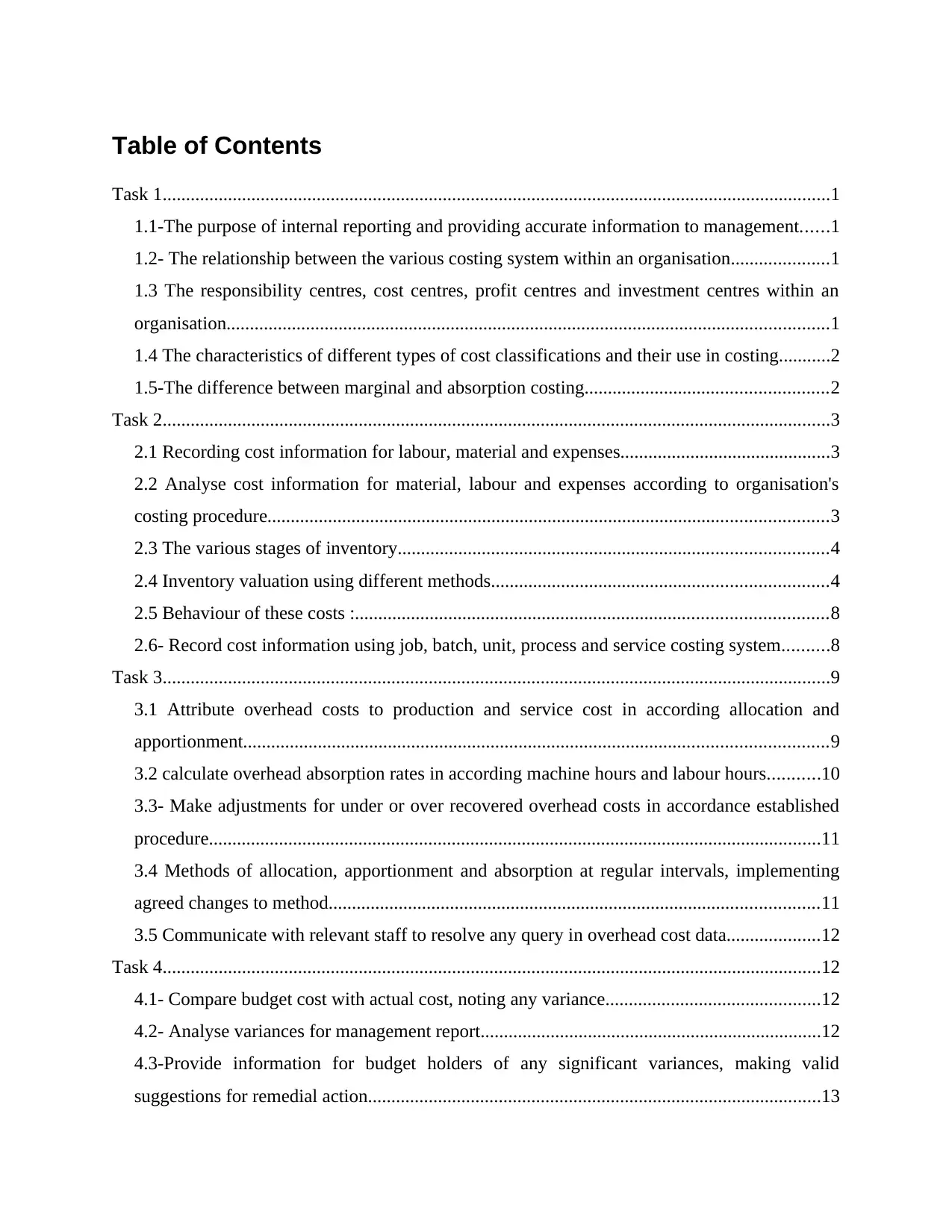
Table of Contents
Task 1...............................................................................................................................................1
1.1-The purpose of internal reporting and providing accurate information to management......1
1.2- The relationship between the various costing system within an organisation.....................1
1.3 The responsibility centres, cost centres, profit centres and investment centres within an
organisation.................................................................................................................................1
1.4 The characteristics of different types of cost classifications and their use in costing...........2
1.5-The difference between marginal and absorption costing....................................................2
Task 2...............................................................................................................................................3
2.1 Recording cost information for labour, material and expenses.............................................3
2.2 Analyse cost information for material, labour and expenses according to organisation's
costing procedure........................................................................................................................3
2.3 The various stages of inventory............................................................................................4
2.4 Inventory valuation using different methods........................................................................4
2.5 Behaviour of these costs :.....................................................................................................8
2.6- Record cost information using job, batch, unit, process and service costing system..........8
Task 3...............................................................................................................................................9
3.1 Attribute overhead costs to production and service cost in according allocation and
apportionment.............................................................................................................................9
3.2 calculate overhead absorption rates in according machine hours and labour hours...........10
3.3- Make adjustments for under or over recovered overhead costs in accordance established
procedure...................................................................................................................................11
3.4 Methods of allocation, apportionment and absorption at regular intervals, implementing
agreed changes to method.........................................................................................................11
3.5 Communicate with relevant staff to resolve any query in overhead cost data....................12
Task 4.............................................................................................................................................12
4.1- Compare budget cost with actual cost, noting any variance..............................................12
4.2- Analyse variances for management report.........................................................................12
4.3-Provide information for budget holders of any significant variances, making valid
suggestions for remedial action.................................................................................................13
Task 1...............................................................................................................................................1
1.1-The purpose of internal reporting and providing accurate information to management......1
1.2- The relationship between the various costing system within an organisation.....................1
1.3 The responsibility centres, cost centres, profit centres and investment centres within an
organisation.................................................................................................................................1
1.4 The characteristics of different types of cost classifications and their use in costing...........2
1.5-The difference between marginal and absorption costing....................................................2
Task 2...............................................................................................................................................3
2.1 Recording cost information for labour, material and expenses.............................................3
2.2 Analyse cost information for material, labour and expenses according to organisation's
costing procedure........................................................................................................................3
2.3 The various stages of inventory............................................................................................4
2.4 Inventory valuation using different methods........................................................................4
2.5 Behaviour of these costs :.....................................................................................................8
2.6- Record cost information using job, batch, unit, process and service costing system..........8
Task 3...............................................................................................................................................9
3.1 Attribute overhead costs to production and service cost in according allocation and
apportionment.............................................................................................................................9
3.2 calculate overhead absorption rates in according machine hours and labour hours...........10
3.3- Make adjustments for under or over recovered overhead costs in accordance established
procedure...................................................................................................................................11
3.4 Methods of allocation, apportionment and absorption at regular intervals, implementing
agreed changes to method.........................................................................................................11
3.5 Communicate with relevant staff to resolve any query in overhead cost data....................12
Task 4.............................................................................................................................................12
4.1- Compare budget cost with actual cost, noting any variance..............................................12
4.2- Analyse variances for management report.........................................................................12
4.3-Provide information for budget holders of any significant variances, making valid
suggestions for remedial action.................................................................................................13
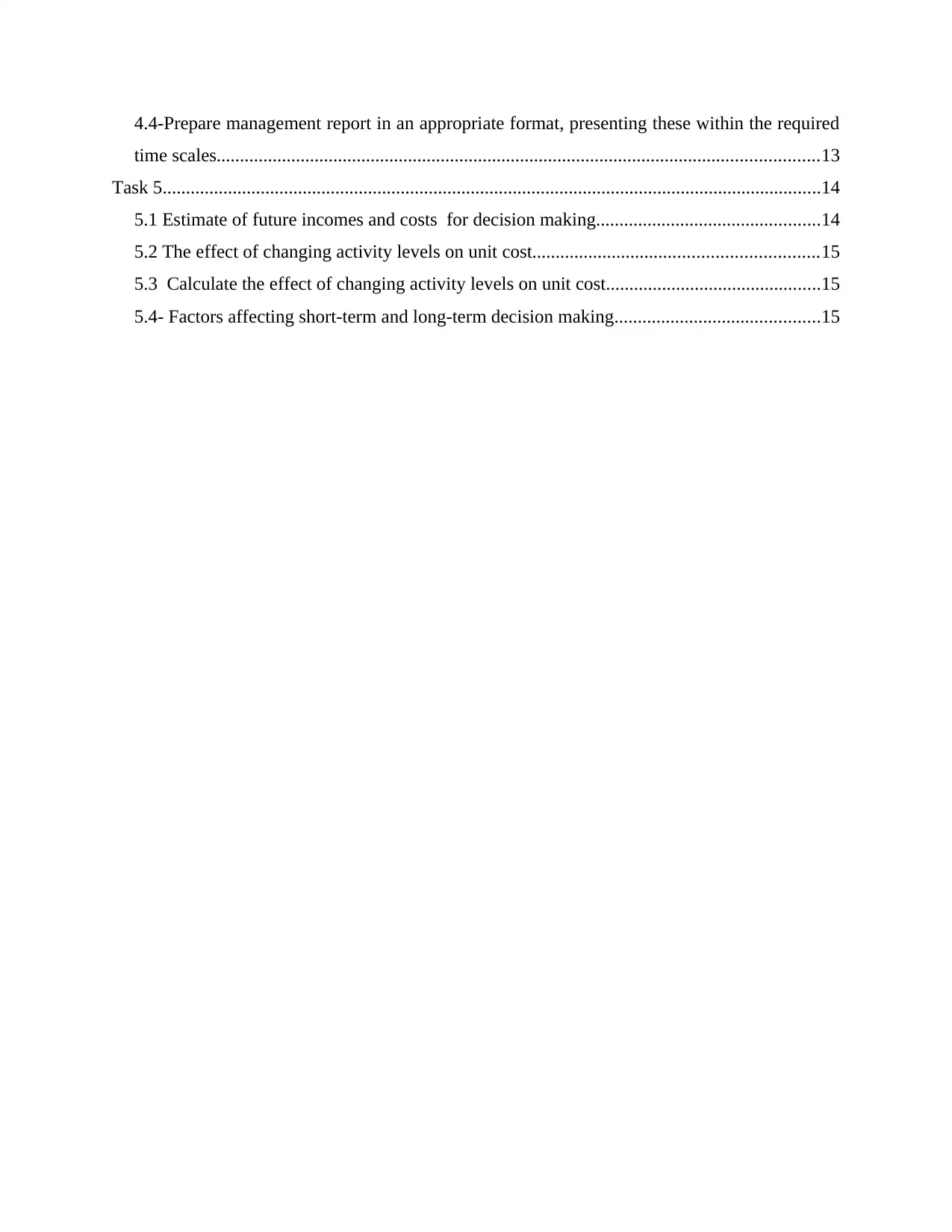
4.4-Prepare management report in an appropriate format, presenting these within the required
time scales.................................................................................................................................13
Task 5.............................................................................................................................................14
5.1 Estimate of future incomes and costs for decision making................................................14
5.2 The effect of changing activity levels on unit cost.............................................................15
5.3 Calculate the effect of changing activity levels on unit cost..............................................15
5.4- Factors affecting short-term and long-term decision making............................................15
time scales.................................................................................................................................13
Task 5.............................................................................................................................................14
5.1 Estimate of future incomes and costs for decision making................................................14
5.2 The effect of changing activity levels on unit cost.............................................................15
5.3 Calculate the effect of changing activity levels on unit cost..............................................15
5.4- Factors affecting short-term and long-term decision making............................................15
⊘ This is a preview!⊘
Do you want full access?
Subscribe today to unlock all pages.

Trusted by 1+ million students worldwide
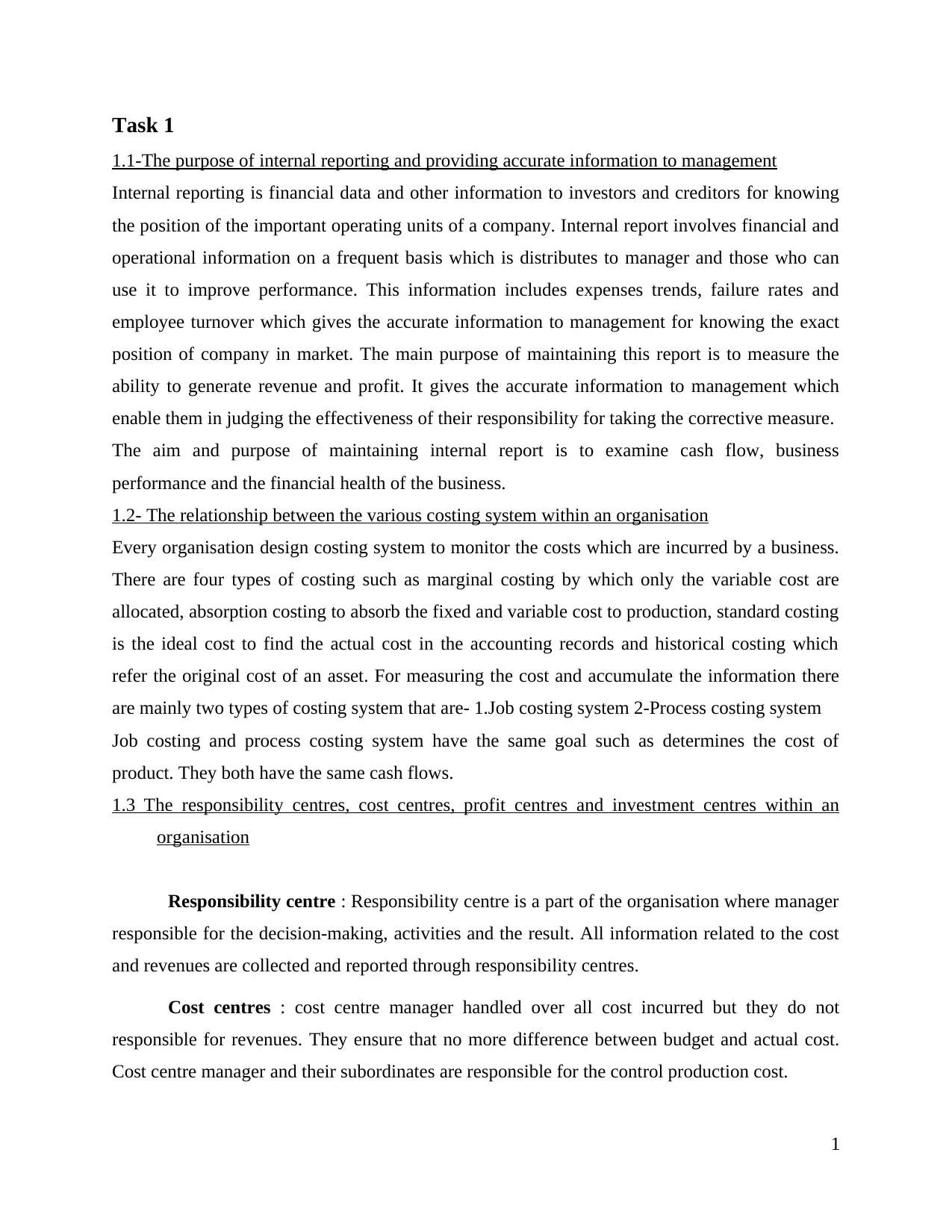
Task 1
1.1-The purpose of internal reporting and providing accurate information to management
Internal reporting is financial data and other information to investors and creditors for knowing
the position of the important operating units of a company. Internal report involves financial and
operational information on a frequent basis which is distributes to manager and those who can
use it to improve performance. This information includes expenses trends, failure rates and
employee turnover which gives the accurate information to management for knowing the exact
position of company in market. The main purpose of maintaining this report is to measure the
ability to generate revenue and profit. It gives the accurate information to management which
enable them in judging the effectiveness of their responsibility for taking the corrective measure.
The aim and purpose of maintaining internal report is to examine cash flow, business
performance and the financial health of the business.
1.2- The relationship between the various costing system within an organisation
Every organisation design costing system to monitor the costs which are incurred by a business.
There are four types of costing such as marginal costing by which only the variable cost are
allocated, absorption costing to absorb the fixed and variable cost to production, standard costing
is the ideal cost to find the actual cost in the accounting records and historical costing which
refer the original cost of an asset. For measuring the cost and accumulate the information there
are mainly two types of costing system that are- 1.Job costing system 2-Process costing system
Job costing and process costing system have the same goal such as determines the cost of
product. They both have the same cash flows.
1.3 The responsibility centres, cost centres, profit centres and investment centres within an
organisation
Responsibility centre : Responsibility centre is a part of the organisation where manager
responsible for the decision-making, activities and the result. All information related to the cost
and revenues are collected and reported through responsibility centres.
Cost centres : cost centre manager handled over all cost incurred but they do not
responsible for revenues. They ensure that no more difference between budget and actual cost.
Cost centre manager and their subordinates are responsible for the control production cost.
1
1.1-The purpose of internal reporting and providing accurate information to management
Internal reporting is financial data and other information to investors and creditors for knowing
the position of the important operating units of a company. Internal report involves financial and
operational information on a frequent basis which is distributes to manager and those who can
use it to improve performance. This information includes expenses trends, failure rates and
employee turnover which gives the accurate information to management for knowing the exact
position of company in market. The main purpose of maintaining this report is to measure the
ability to generate revenue and profit. It gives the accurate information to management which
enable them in judging the effectiveness of their responsibility for taking the corrective measure.
The aim and purpose of maintaining internal report is to examine cash flow, business
performance and the financial health of the business.
1.2- The relationship between the various costing system within an organisation
Every organisation design costing system to monitor the costs which are incurred by a business.
There are four types of costing such as marginal costing by which only the variable cost are
allocated, absorption costing to absorb the fixed and variable cost to production, standard costing
is the ideal cost to find the actual cost in the accounting records and historical costing which
refer the original cost of an asset. For measuring the cost and accumulate the information there
are mainly two types of costing system that are- 1.Job costing system 2-Process costing system
Job costing and process costing system have the same goal such as determines the cost of
product. They both have the same cash flows.
1.3 The responsibility centres, cost centres, profit centres and investment centres within an
organisation
Responsibility centre : Responsibility centre is a part of the organisation where manager
responsible for the decision-making, activities and the result. All information related to the cost
and revenues are collected and reported through responsibility centres.
Cost centres : cost centre manager handled over all cost incurred but they do not
responsible for revenues. They ensure that no more difference between budget and actual cost.
Cost centre manager and their subordinates are responsible for the control production cost.
1
Paraphrase This Document
Need a fresh take? Get an instant paraphrase of this document with our AI Paraphraser
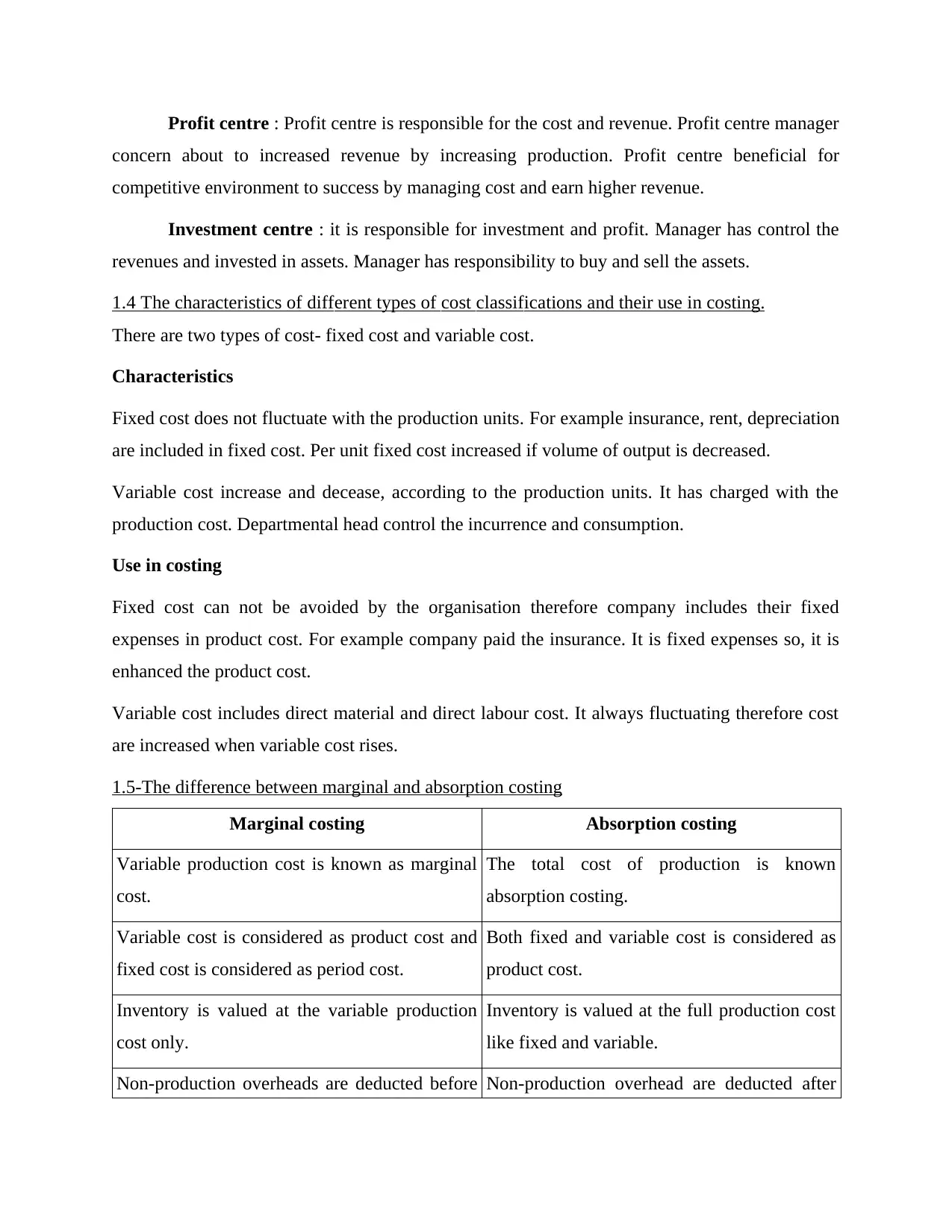
Profit centre : Profit centre is responsible for the cost and revenue. Profit centre manager
concern about to increased revenue by increasing production. Profit centre beneficial for
competitive environment to success by managing cost and earn higher revenue.
Investment centre : it is responsible for investment and profit. Manager has control the
revenues and invested in assets. Manager has responsibility to buy and sell the assets.
1.4 The characteristics of different types of cost classifications and their use in costing.
There are two types of cost- fixed cost and variable cost.
Characteristics
Fixed cost does not fluctuate with the production units. For example insurance, rent, depreciation
are included in fixed cost. Per unit fixed cost increased if volume of output is decreased.
Variable cost increase and decease, according to the production units. It has charged with the
production cost. Departmental head control the incurrence and consumption.
Use in costing
Fixed cost can not be avoided by the organisation therefore company includes their fixed
expenses in product cost. For example company paid the insurance. It is fixed expenses so, it is
enhanced the product cost.
Variable cost includes direct material and direct labour cost. It always fluctuating therefore cost
are increased when variable cost rises.
1.5-The difference between marginal and absorption costing
Marginal costing Absorption costing
Variable production cost is known as marginal
cost.
The total cost of production is known
absorption costing.
Variable cost is considered as product cost and
fixed cost is considered as period cost.
Both fixed and variable cost is considered as
product cost.
Inventory is valued at the variable production
cost only.
Inventory is valued at the full production cost
like fixed and variable.
Non-production overheads are deducted before Non-production overhead are deducted after
concern about to increased revenue by increasing production. Profit centre beneficial for
competitive environment to success by managing cost and earn higher revenue.
Investment centre : it is responsible for investment and profit. Manager has control the
revenues and invested in assets. Manager has responsibility to buy and sell the assets.
1.4 The characteristics of different types of cost classifications and their use in costing.
There are two types of cost- fixed cost and variable cost.
Characteristics
Fixed cost does not fluctuate with the production units. For example insurance, rent, depreciation
are included in fixed cost. Per unit fixed cost increased if volume of output is decreased.
Variable cost increase and decease, according to the production units. It has charged with the
production cost. Departmental head control the incurrence and consumption.
Use in costing
Fixed cost can not be avoided by the organisation therefore company includes their fixed
expenses in product cost. For example company paid the insurance. It is fixed expenses so, it is
enhanced the product cost.
Variable cost includes direct material and direct labour cost. It always fluctuating therefore cost
are increased when variable cost rises.
1.5-The difference between marginal and absorption costing
Marginal costing Absorption costing
Variable production cost is known as marginal
cost.
The total cost of production is known
absorption costing.
Variable cost is considered as product cost and
fixed cost is considered as period cost.
Both fixed and variable cost is considered as
product cost.
Inventory is valued at the variable production
cost only.
Inventory is valued at the full production cost
like fixed and variable.
Non-production overheads are deducted before Non-production overhead are deducted after
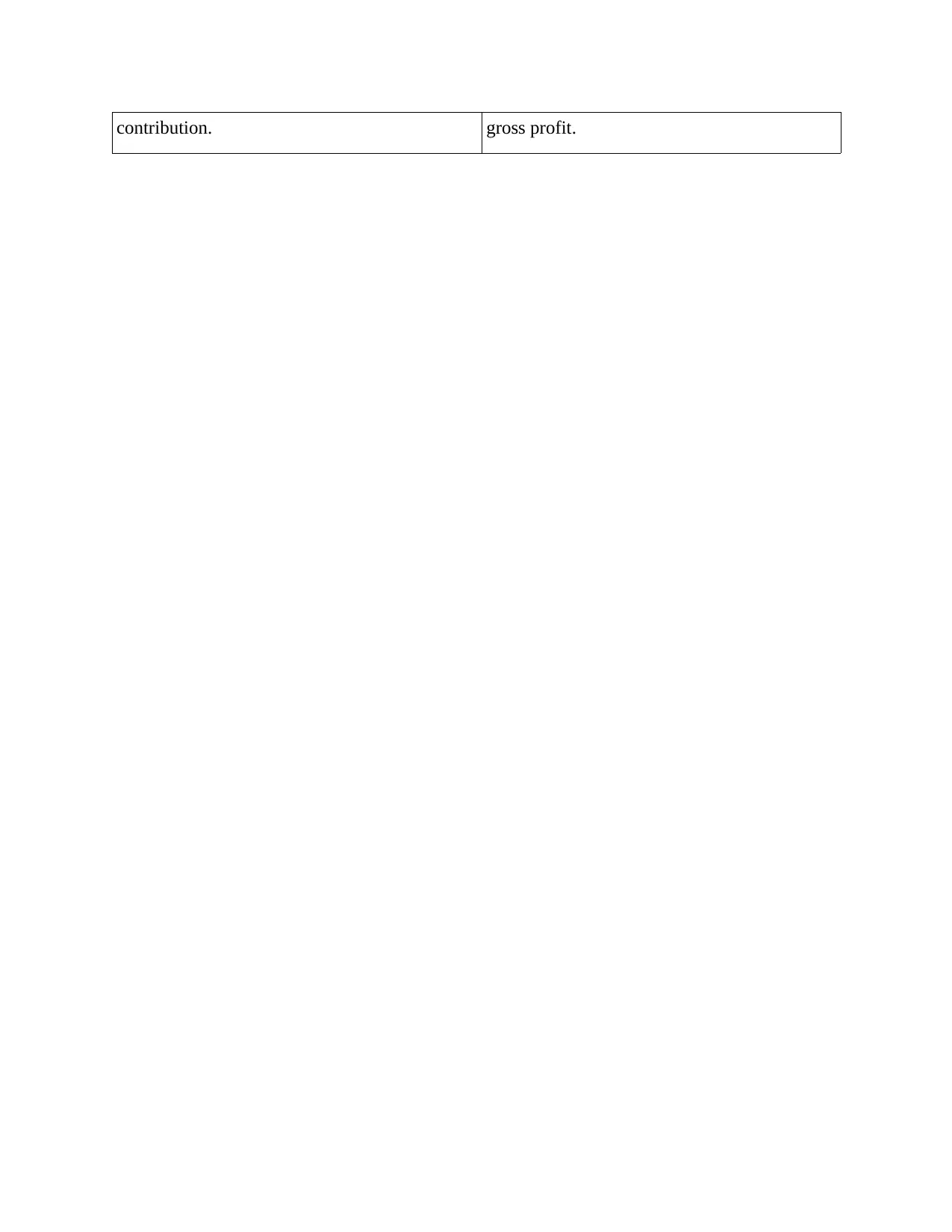
contribution. gross profit.
⊘ This is a preview!⊘
Do you want full access?
Subscribe today to unlock all pages.

Trusted by 1+ million students worldwide
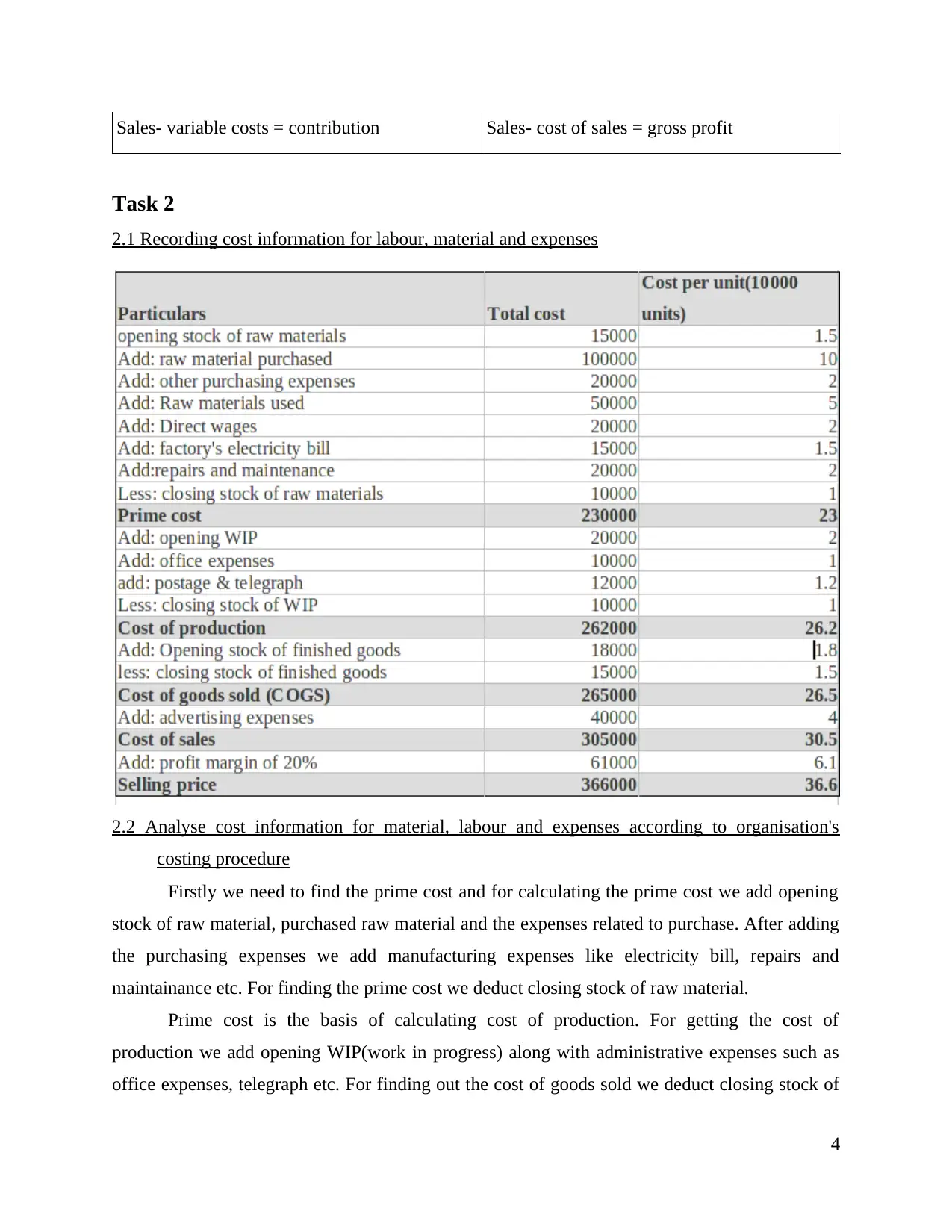
Sales- variable costs = contribution Sales- cost of sales = gross profit
Task 2
2.1 Recording cost information for labour, material and expenses
2.2 Analyse cost information for material, labour and expenses according to organisation's
costing procedure
Firstly we need to find the prime cost and for calculating the prime cost we add opening
stock of raw material, purchased raw material and the expenses related to purchase. After adding
the purchasing expenses we add manufacturing expenses like electricity bill, repairs and
maintainance etc. For finding the prime cost we deduct closing stock of raw material.
Prime cost is the basis of calculating cost of production. For getting the cost of
production we add opening WIP(work in progress) along with administrative expenses such as
office expenses, telegraph etc. For finding out the cost of goods sold we deduct closing stock of
4
Task 2
2.1 Recording cost information for labour, material and expenses
2.2 Analyse cost information for material, labour and expenses according to organisation's
costing procedure
Firstly we need to find the prime cost and for calculating the prime cost we add opening
stock of raw material, purchased raw material and the expenses related to purchase. After adding
the purchasing expenses we add manufacturing expenses like electricity bill, repairs and
maintainance etc. For finding the prime cost we deduct closing stock of raw material.
Prime cost is the basis of calculating cost of production. For getting the cost of
production we add opening WIP(work in progress) along with administrative expenses such as
office expenses, telegraph etc. For finding out the cost of goods sold we deduct closing stock of
4
Paraphrase This Document
Need a fresh take? Get an instant paraphrase of this document with our AI Paraphraser
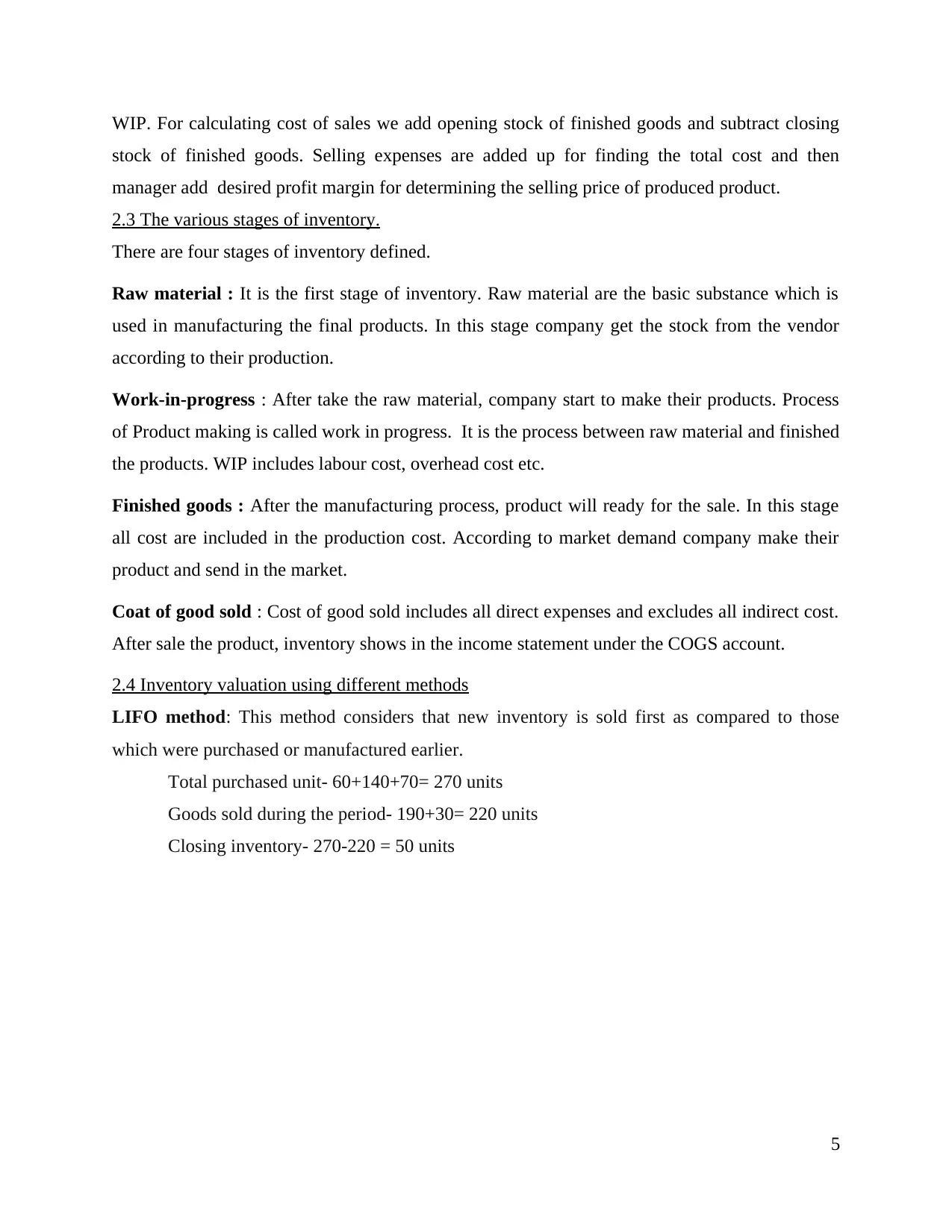
WIP. For calculating cost of sales we add opening stock of finished goods and subtract closing
stock of finished goods. Selling expenses are added up for finding the total cost and then
manager add desired profit margin for determining the selling price of produced product.
2.3 The various stages of inventory.
There are four stages of inventory defined.
Raw material : It is the first stage of inventory. Raw material are the basic substance which is
used in manufacturing the final products. In this stage company get the stock from the vendor
according to their production.
Work-in-progress : After take the raw material, company start to make their products. Process
of Product making is called work in progress. It is the process between raw material and finished
the products. WIP includes labour cost, overhead cost etc.
Finished goods : After the manufacturing process, product will ready for the sale. In this stage
all cost are included in the production cost. According to market demand company make their
product and send in the market.
Coat of good sold : Cost of good sold includes all direct expenses and excludes all indirect cost.
After sale the product, inventory shows in the income statement under the COGS account.
2.4 Inventory valuation using different methods
LIFO method: This method considers that new inventory is sold first as compared to those
which were purchased or manufactured earlier.
Total purchased unit- 60+140+70= 270 units
Goods sold during the period- 190+30= 220 units
Closing inventory- 270-220 = 50 units
5
stock of finished goods. Selling expenses are added up for finding the total cost and then
manager add desired profit margin for determining the selling price of produced product.
2.3 The various stages of inventory.
There are four stages of inventory defined.
Raw material : It is the first stage of inventory. Raw material are the basic substance which is
used in manufacturing the final products. In this stage company get the stock from the vendor
according to their production.
Work-in-progress : After take the raw material, company start to make their products. Process
of Product making is called work in progress. It is the process between raw material and finished
the products. WIP includes labour cost, overhead cost etc.
Finished goods : After the manufacturing process, product will ready for the sale. In this stage
all cost are included in the production cost. According to market demand company make their
product and send in the market.
Coat of good sold : Cost of good sold includes all direct expenses and excludes all indirect cost.
After sale the product, inventory shows in the income statement under the COGS account.
2.4 Inventory valuation using different methods
LIFO method: This method considers that new inventory is sold first as compared to those
which were purchased or manufactured earlier.
Total purchased unit- 60+140+70= 270 units
Goods sold during the period- 190+30= 220 units
Closing inventory- 270-220 = 50 units
5
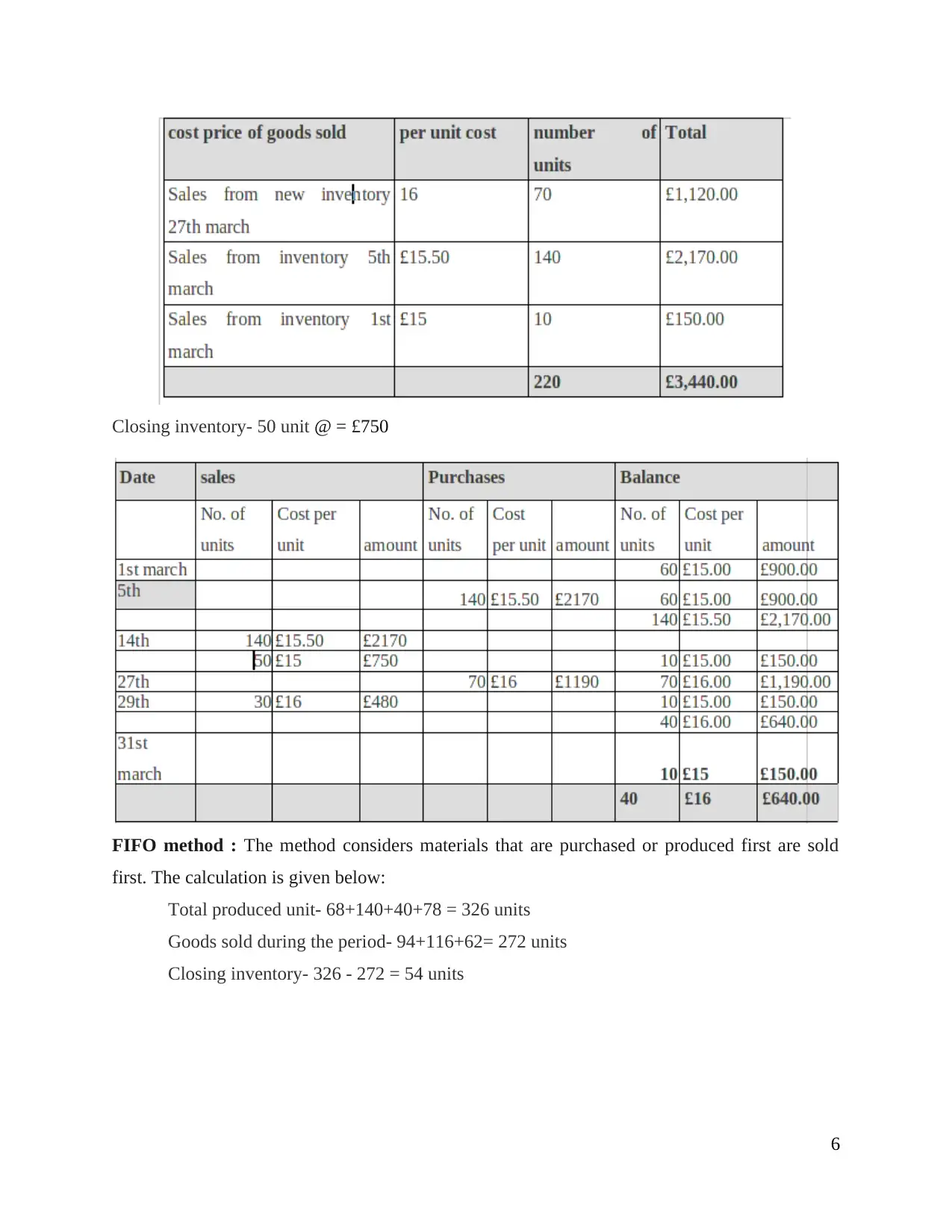
Closing inventory- 50 unit @ = £750
FIFO method : The method considers materials that are purchased or produced first are sold
first. The calculation is given below:
Total produced unit- 68+140+40+78 = 326 units
Goods sold during the period- 94+116+62= 272 units
Closing inventory- 326 - 272 = 54 units
6
FIFO method : The method considers materials that are purchased or produced first are sold
first. The calculation is given below:
Total produced unit- 68+140+40+78 = 326 units
Goods sold during the period- 94+116+62= 272 units
Closing inventory- 326 - 272 = 54 units
6
⊘ This is a preview!⊘
Do you want full access?
Subscribe today to unlock all pages.

Trusted by 1+ million students worldwide
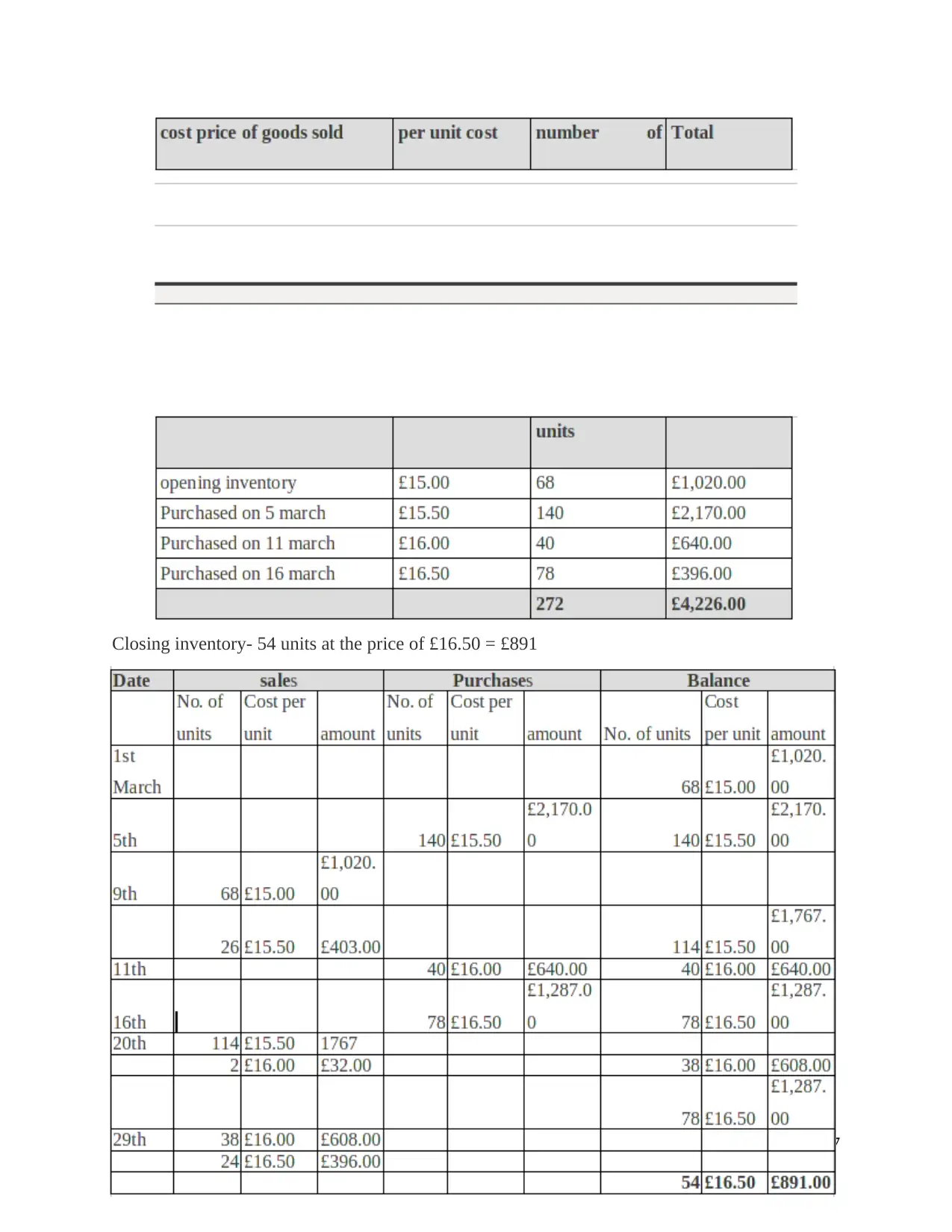
Closing inventory- 54 units at the price of £16.50 = £891
7
7
Paraphrase This Document
Need a fresh take? Get an instant paraphrase of this document with our AI Paraphraser
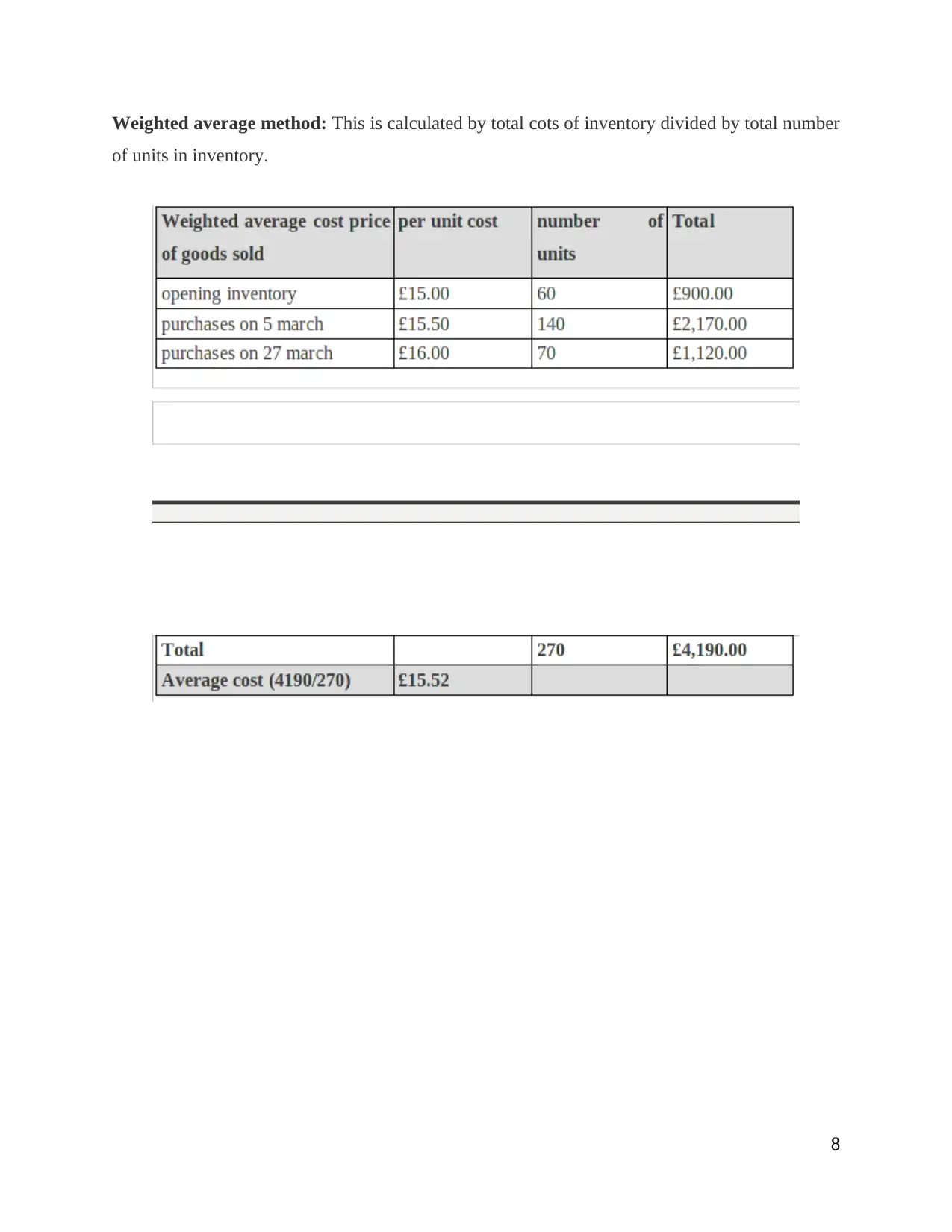
Weighted average method: This is calculated by total cots of inventory divided by total number
of units in inventory.
8
of units in inventory.
8
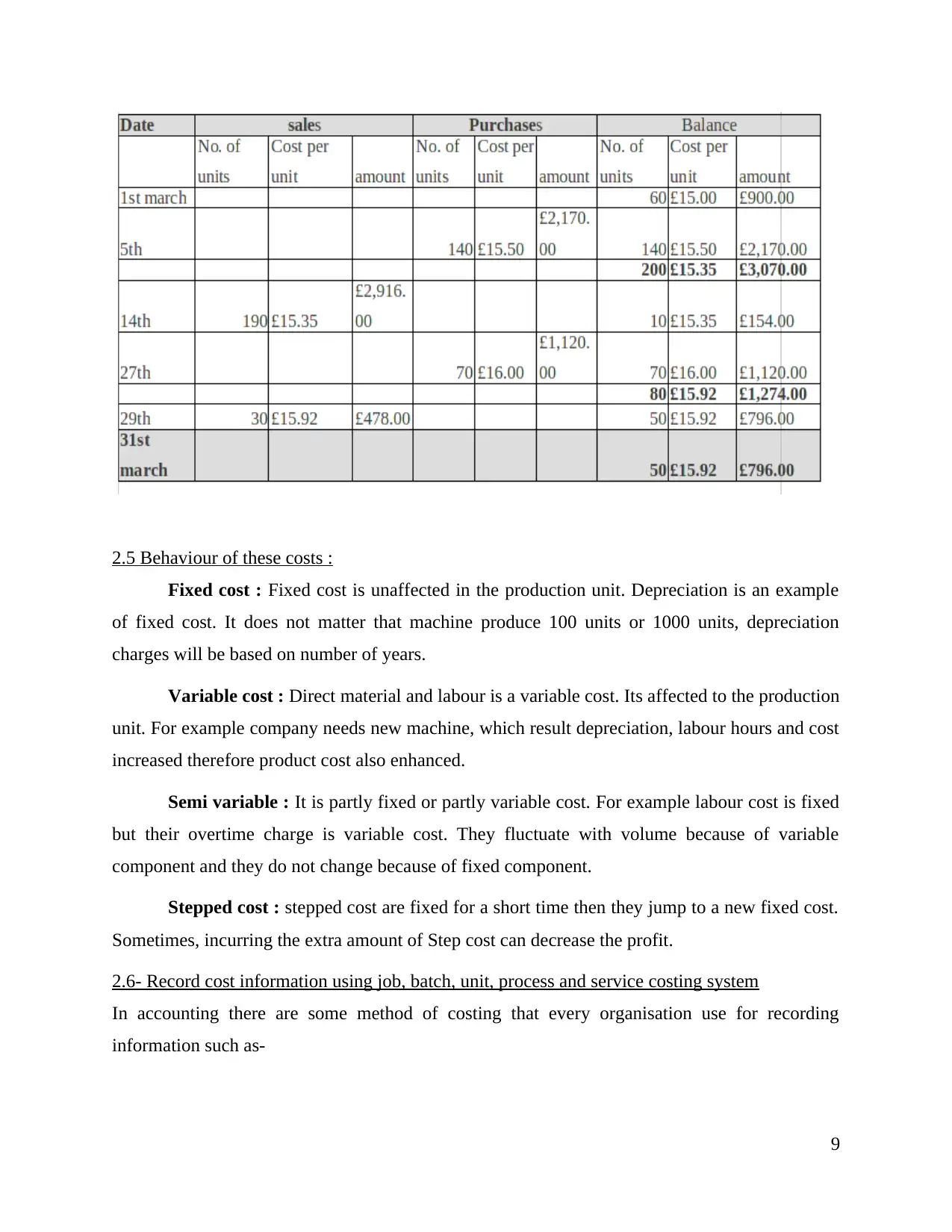
2.5 Behaviour of these costs :
Fixed cost : Fixed cost is unaffected in the production unit. Depreciation is an example
of fixed cost. It does not matter that machine produce 100 units or 1000 units, depreciation
charges will be based on number of years.
Variable cost : Direct material and labour is a variable cost. Its affected to the production
unit. For example company needs new machine, which result depreciation, labour hours and cost
increased therefore product cost also enhanced.
Semi variable : It is partly fixed or partly variable cost. For example labour cost is fixed
but their overtime charge is variable cost. They fluctuate with volume because of variable
component and they do not change because of fixed component.
Stepped cost : stepped cost are fixed for a short time then they jump to a new fixed cost.
Sometimes, incurring the extra amount of Step cost can decrease the profit.
2.6- Record cost information using job, batch, unit, process and service costing system
In accounting there are some method of costing that every organisation use for recording
information such as-
9
Fixed cost : Fixed cost is unaffected in the production unit. Depreciation is an example
of fixed cost. It does not matter that machine produce 100 units or 1000 units, depreciation
charges will be based on number of years.
Variable cost : Direct material and labour is a variable cost. Its affected to the production
unit. For example company needs new machine, which result depreciation, labour hours and cost
increased therefore product cost also enhanced.
Semi variable : It is partly fixed or partly variable cost. For example labour cost is fixed
but their overtime charge is variable cost. They fluctuate with volume because of variable
component and they do not change because of fixed component.
Stepped cost : stepped cost are fixed for a short time then they jump to a new fixed cost.
Sometimes, incurring the extra amount of Step cost can decrease the profit.
2.6- Record cost information using job, batch, unit, process and service costing system
In accounting there are some method of costing that every organisation use for recording
information such as-
9
⊘ This is a preview!⊘
Do you want full access?
Subscribe today to unlock all pages.

Trusted by 1+ million students worldwide
1 out of 19
Related Documents
Your All-in-One AI-Powered Toolkit for Academic Success.
+13062052269
info@desklib.com
Available 24*7 on WhatsApp / Email
![[object Object]](/_next/static/media/star-bottom.7253800d.svg)
Unlock your academic potential
Copyright © 2020–2025 A2Z Services. All Rights Reserved. Developed and managed by ZUCOL.





